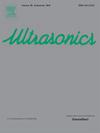Multiple bolt looseness detection using SH-typed guided waves: Integrating physical mechanism with monitoring data
IF 3.8
2区 物理与天体物理
Q1 ACOUSTICS
引用次数: 0
Abstract
Bolts, functioning as critical components in connecting structures, play an essential role across various engineering industries. The guided wave method has demonstrated significant potential in detecting bolt looseness with high efficiency. However, identifying the looseness condition of the joint with multiple bolts remains challenging. Various machine learning methods were introduced to extract features from the received signals, yet those that possess a clear physical interpretation in engineering tend to achieve superior application outcomes. Therefore, a physics-informed convolutional neural network (PICNN) is presented for bolt looseness localization and severity estimation for a lap joint connected by eight bolts. A small number of SH-typed magnetostrictive transducers, arranged in a pitch-catch configuration, were used to obtained the transmitted waves from various wave propagation paths. The combined time–frequency spectrum derived from the wavelet transform results of four transmitted waves was used as the input to the model. The relationship between the normalized wave energy transmission ratios and the local bolt looseness severity was revealed by the backpropagation neural network, which is regarded as the wave energy propagation mechanism within the PICNN. Numerical and experimental results indicate that the bolt looseness conditions can be successfully estimated. Time masking and frequency masking data augmentation was performed on the limited experimental samples, and the transfer learning technique was proposed to enhance the bolt looseness detection accuracy.
sh型导波多螺栓松动检测:将物理机制与监测数据相结合
螺栓作为连接结构的关键部件,在各种工程行业中发挥着重要作用。导波法在高效检测螺栓松动方面显示出巨大的潜力。然而,确定多个螺栓连接的松动情况仍然具有挑战性。引入了各种机器学习方法来从接收到的信号中提取特征,然而那些在工程中具有明确物理解释的机器学习方法往往会取得更好的应用结果。为此,提出了一种基于物理信息的卷积神经网络(PICNN),用于8个螺栓连接的搭接螺栓松动定位和严重程度估计。采用少量的sh型磁致伸缩换能器,排列成节距捕获结构,从不同的波传播路径获得透射波。利用4个发射波的小波变换结果得到的时频组合谱作为模型的输入。通过反向传播神经网络揭示了归一化波能传输比与局部螺栓松动程度之间的关系,并将其视为PICNN内的波能传播机制。数值和实验结果表明,该方法可以较好地估计锚杆的松动情况。对有限的实验样本进行时间掩模和频率掩模数据增强,并提出迁移学习技术提高螺栓松动检测精度。
本文章由计算机程序翻译,如有差异,请以英文原文为准。
求助全文
约1分钟内获得全文
求助全文
来源期刊

Ultrasonics
医学-核医学
CiteScore
7.60
自引率
19.00%
发文量
186
审稿时长
3.9 months
期刊介绍:
Ultrasonics is the only internationally established journal which covers the entire field of ultrasound research and technology and all its many applications. Ultrasonics contains a variety of sections to keep readers fully informed and up-to-date on the whole spectrum of research and development throughout the world. Ultrasonics publishes papers of exceptional quality and of relevance to both academia and industry. Manuscripts in which ultrasonics is a central issue and not simply an incidental tool or minor issue, are welcomed.
As well as top quality original research papers and review articles by world renowned experts, Ultrasonics also regularly features short communications, a calendar of forthcoming events and special issues dedicated to topical subjects.
 求助内容:
求助内容: 应助结果提醒方式:
应助结果提醒方式:


